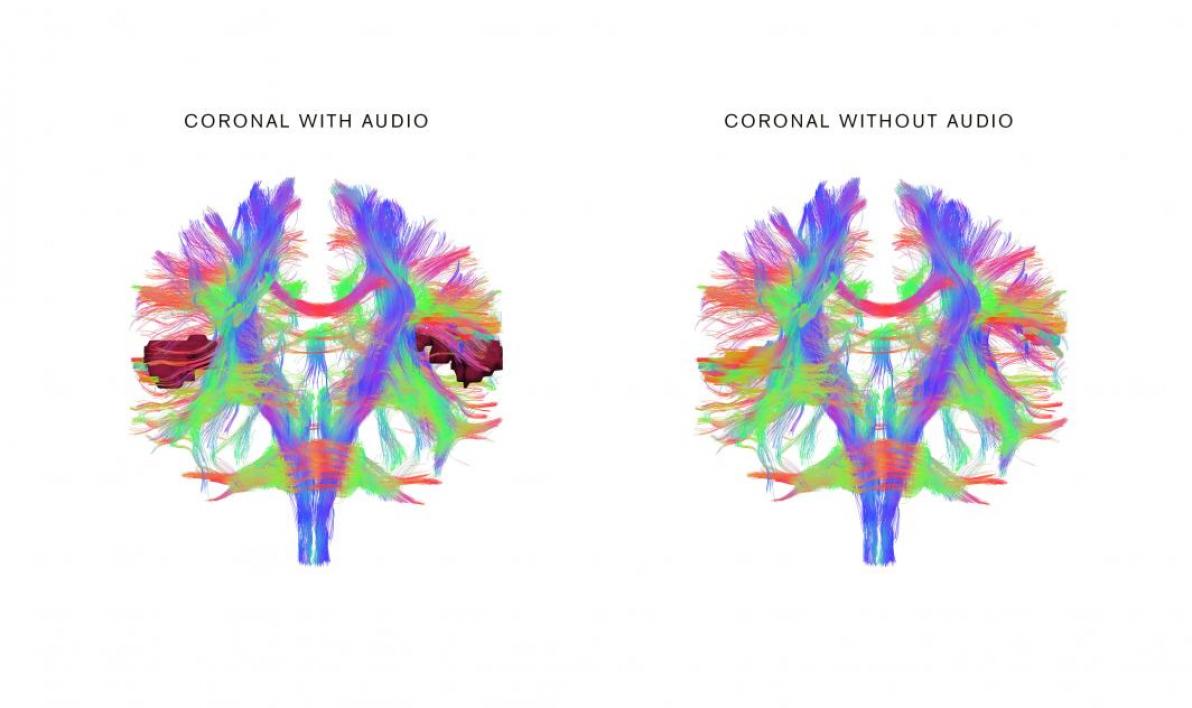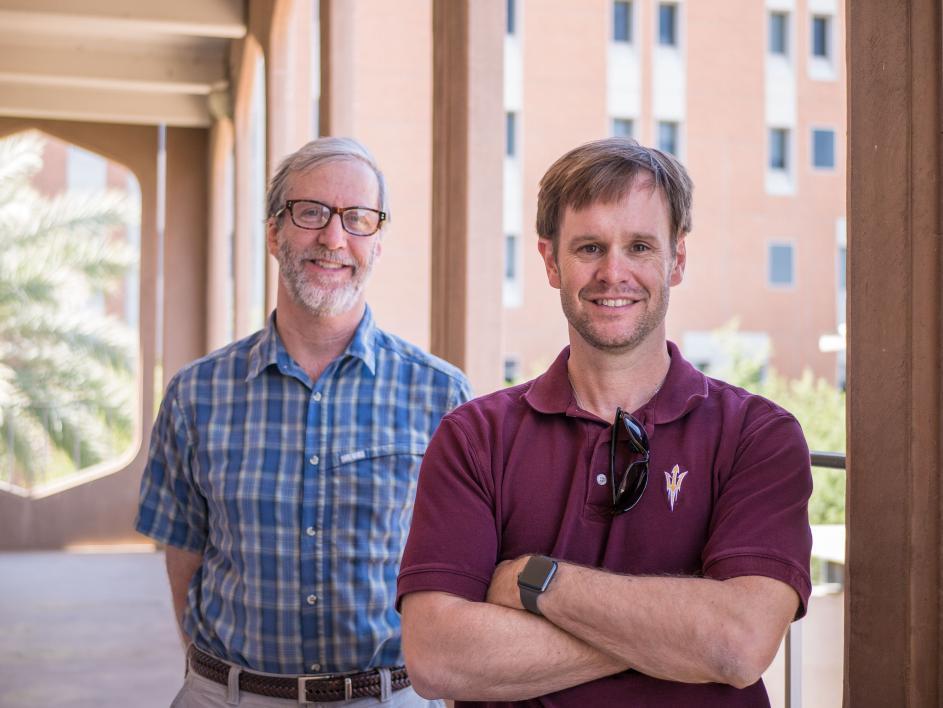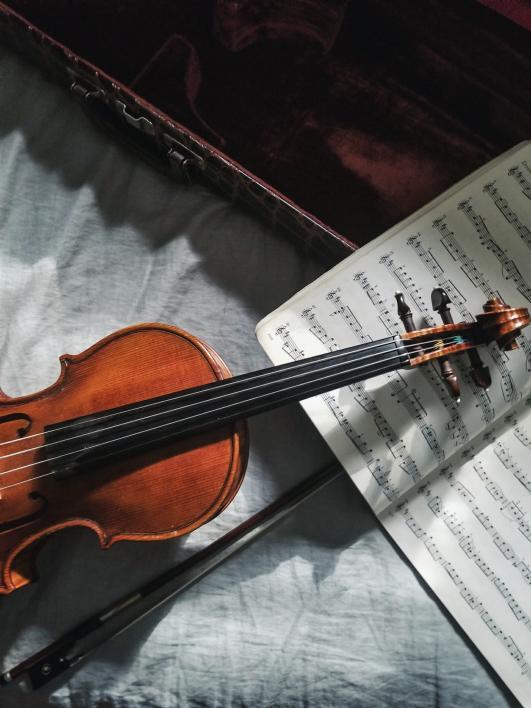ASU researchers pursue neural mechanisms of music perception

Michael McBeath (left) and Samuel McClure, professors in the ASU Department of Psychology, are studying how people perceive music. Photo by Robert Ewing
In a famous social experiment a decade ago, a world-renowned violinist stood against a wall in a Washington, D.C., subway station and expertly played one of the most difficult pieces of music in history on a violin worth more than $3 million. Of the more than 1,000 people who walked by violinist Joshua Bell as he played that morning, only seven stopped to listen.
Why were people unable to recognize they were hearing world-famous music?
One answer is: context matters. A few days before he stood in the subway station, Bell played to a full theater in Boston, where the cheapest tickets were $100.
In a theater, people expect to see a world-famous violinist and hear excellent music. In a subway station, they do not expect Joshua Bell to be playing Johann Sebastian Bach’s “Chaconne” on his one-of-a-kind Stradivari violin.
Researchers in the Arizona State University Department of Psychology, along with collaborators from the University of Connecticut and the University of Arkansas, measured what was happening in the brain during a version of the Joshua Bell experiment. The findings from their study were published in the April 18 issue of Scientific Reports.
“We wanted to test whether having contextual information about a musical performance affected what people thought about the music,” said Göekhan Aydogan, a postdoctoral researcher in ASU’s Decision Neuroscience Lab, “And we wanted to see how the brain handled this information which was not directly related to the quality of the musical performance.”
In the experiment, participants listened to pieces of music that were just over a minute long while the researchers used functional magnetic resonance imaging (MRI) to measure brain activity. Before the music sounded, the researchers either told participants it was played by a student or a professional musician. This information gave the participants context about the music they were about to hear.
“Standard economic theory assumes that people are rational, and the contextual information need not be considered when deciding on the quality of the music,” Aydogan said.
The researchers found that participants perceived the music differently. They rated pieces they thought were played by professionals higher than those played by students. The researchers found differences in brain activity that depended on who played the music.
“We found an attentional bias effect,” Aydogan said. “Measures of neural activity were higher in the auditory cortex for the entire time people were listening to music reportedly played by a professional.”
Half of the time, when the participants thought they were listening to music played by a professional, it was actually a student. This mismatch allowed the researchers to study how people were able to change their opinions about the music.
They found that an important part of the executive control network, the dorsolateral prefrontal cortex, played a central role in overcoming the initial bias people had from the information about who was playing the music.
“We found that people were biased based on the sensory input they received — the music they heard — and based on the activity we measured in the prefrontal regions, it appears that this bias was reduced when participants engaged in deliberative thinking,” said Srekar Nagishetty Ravi, a senior in the School of Biological and Health Systems Engineering who worked as a research assistant in the Decision Neuroscience Lab.
The researchers found that the strength of the connections between the prefrontal regions and other brain regions indicated how biased people were. Participants with weaker connections to the executive control network were more susceptible to context, or the information about whether a student or professional played the music, when assessing the quality of the music.
“There is very little research on what makes art or music beautiful,” said Samuel McClure, associate professor of psychology and head of the Decision Neuroscience Lab. “There are theories that suggest what artists do is discover by chance the principles of how our brains represent visual scenes or sound, and science has yet to define these principles.”
ASU researchers are now working to test such theories.
McClure recently joined an interdisciplinary group of ASU professors, lecturers and students who are all interested in the science of music perception. The researchers named themselves “The Science of Art, Music and Brain Activity” or SAMBA for short. They meet once a week at 3:14, in honor of pi, and are planning a series of neuroimaging experiments to map how people perceive music.
The idea for the SAMBA group came from Jeffrey Atchison, a post-baccalaureate student working toward a degree in psychology. Atchison’s first degree, also from ASU, is in music. He worked as a music educator in the Phoenix area before deciding to return to ASU.
“The more I taught, the more I had questions about how students processed music and interacted with musical concepts,” Atchison said. “I decided I had to try and understand the biological and neural mechanisms underlying how we perceive music.”
Atchison recruited his former mentor Joshua Gardner, clinical associate professor of music, to join him in the study of music perception.
“Music has been around for a very long time — some flutes date to 40,000 years ago — and is everywhere,” Gardner said. “The experiments we are planning will help us understand the cognitive processes that occur when we experience music as listeners or performers, which is interesting from a curiosity and pedagogical standpoint.”
Atchison also met with Michael McBeath, professor of psychology, and McBeath publicized and promoted the group. Additional members of the interdisciplinary SAMBA group include Xin Luo, assistant professor of speech and hearing development; Vaughn Becker, associate professor in the School for the Future of Innovation in Society; Jakob Patten, lecturer in psychology, and Seth Gory, an ASU music student.
More Science and technology

ASU to host 2 new 51 Pegasi b Fellows, cementing leadership in exoplanet research
Arizona State University continues its rapid rise in planetary astronomy, welcoming two new 51 Pegasi b Fellows to its exoplanet…

ASU students win big at homeland security design challenge
By Cynthia GerberArizona State University students took home five prizes — including two first-place victories — from this year’s…

Swarm science: Oral bacteria move in waves to spread and survive
Swarming behaviors appear everywhere in nature — from schools of fish darting in synchrony to locusts sweeping across landscapes…




